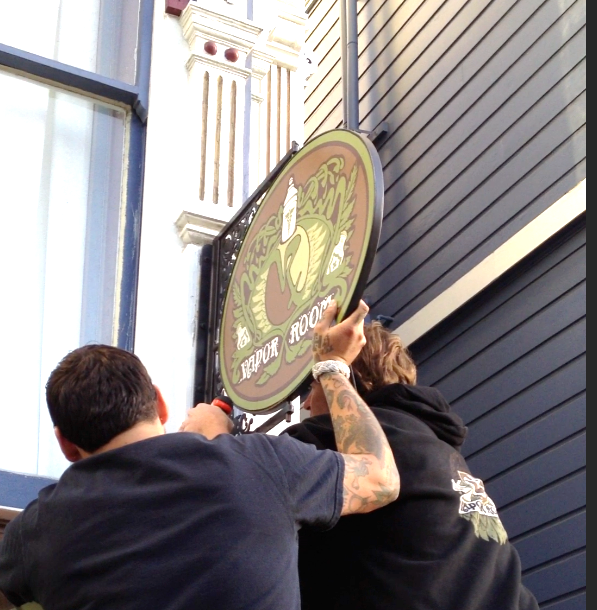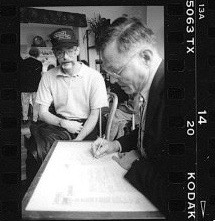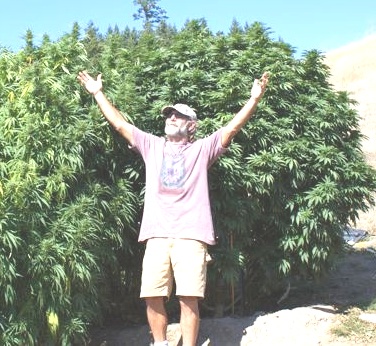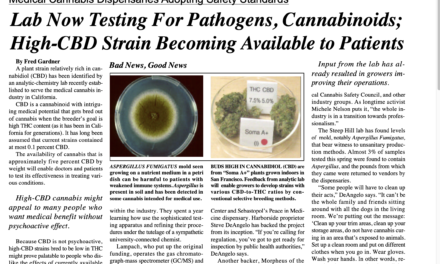By Fred Gardner
As the sun was going down over Twin Peaks on the last day of July, two young men took down the Vapor Room sign. Handpainted and hung on a wrought iron bracket, the sign had not seemed out of place on a Haight Street Victorian built of redwood in a time when carpenters could express their artistry. Inside, people commiserated and said their goodbyes. The United States government had threatened to seize the building if the landlord didn’t evict the club.
And the Vapor Room was a club —a Cannabis club on the original Dennis Peron model, where people could hang out and socialize. It was way smaller than Dennis’s place at 1444 Market Street, but it had the same friendly feeling, as if it was an extension of the proprietor’s living room. Among the 40 people saying goodbye Tuesday evening were some friends of Dennis’s who had circulated petitions for Prop 215 all those years ago. “We were there at the beginning and here we are at the end,” said Kitty, a frail woman who was trying unsuccessfully to hold back the tears.
Unlike the retail outlets that defined themselves as “collectives,” the Vapor Room was organized as a Co-operative Corporation under California law and met all the formal requirements. Attorney Bill Panzer once said the Vapor Room may have been the only marijuana provider in unambiguous compliance with the confusing law (created by legislators to “clarify” Prop 215). If members of the Vapor Room co-op hadn’t liked the way Martin Olive was running the place or allocating funds, they could have voted him out as director.
With only a few exceptions, the entrepreneurs who built the medical cannabis industry after Dennis’s club was taken down in ’98 (as a “nuisance” under California law) did not defend the right of medical cannabis users to consume and socialize on-site. The entrepreneurs’ goal was to sell cannabis —a right-on mission, given the federal prohibition, but a retreat from what Dennis had created and what he and many voters thought Prop 215 had legalized. Sitting with Kitty and her friends I recalled what Dennis had told the Institute of Medicine investigators on their visit to 1444 Market St. in December, 1997: “marijuana is part of it, but the biggest part of healing is not being alone.”
Flashback: The Institute of Medicine Investigates the SF Cannabis Buyers Club
Some influential figures in the medical establishment had been embarrassed by the Dec. 30, 1996 press conference at which top federal officials dismissed as “Cheech and Chong medicine” a therapeutic agent they knew to be effective and safe. An editorial in the New England Journal of Medicine —“Federal Foolishness and Marijuana,” by Jerome Kassirer, MD, the editor-in-chief— called the federal policy “misguided,” “hypocritical,” “out of step with the public,” and “inhumane… the absolute power of bureaucrats whose decisions are based more on reflexive ideology and political correctness than on compassion.”
On January 30, 1997, the very day the NEJM editorial ran, Dr. Harold Varmus, director of the National Institutes of Health, announced that there would be a special conference to resolve “the public health dilemma” raised by the passage of Prop 215.
“I don’t think anyone wants to settle issues like this by plebiscite,” said Varmus, calling instead for “a way to listen to experts on these topics.”
There followed a big conference in February, organized by Alan Leshner of the National Institute of Drug Abuse, at which various experts decreed that there was no proof —which they define as placebo-controlled, double-blind clinical trials— that marijuana was safe and effective medicine in treating pain, neurological and movement disorders, etc.. They called for “more and better studies.”
Next, Gen. Barry McCaffrey, who in December ’96 had mouthed the Cheech-and-Chong soundbite, announced a $1.5 million allocation for a study by the Institute of Medicine (IOM) on the medical potential (and dangers) of marijuana. Somebody evidently had explained to the Four Star Drug Czar that there really are some compounds in the plant that the drug companies hope to develop into marketable synthetics, and that his shop (ONDCP) and NIH, NIDA, DEA, and FDA would from now on be running a five-cornered stall to prevent “the crude plant” from gaining status as medicine. The line would be “more research is needed” —with Prohibition staying in place until the “more research” got conducted.
The Institute of Medicine study was conducted by two male MD “investigators” —Stanley J. Watson, a research psychiatrist from the University of Michigan and John A. Benson, a professor emeritus from Oregon Health Sciences University— and three female “staff.” On a Saturday in December ’97, they visited Bay Area cannabis buyers clubs. It was the day after an appelate court had ruled that Dennis Peron’s club was illegal. The headlines carried Lungren’s vow to close down all the clubs.
Their first stop was the Oakland Cannabis Buyers Co-operative, where Jeff Jones and colleagues described their operation in careful detail. The OCBC had prepared diligently for the meeting, and presented the IOM team with a report on the illnesses their members had been diagnosed with. Tod Mikuriya, MD, explained the advantages of vaporization over smoking. Watson and Benson nodded and the staff took notes. Jones showed them the trays of cuttings that the OCBC provided —along with training— so that members could grow their own plants
The IOM team next visited Dennis Peron’s Market St. club, arriving while a memorial service for Ken M. was being held on the fourth floor. They left to get some lunch, heading towards Van Ness on windy, desolate Market Street. Upstairs, Peron sat alone in the last row, head bowed as friends, co-workers, and family members reminisced about Ken, a person with AIDS who had worked at the club for four years. “The friendliest guy,” Dennis said of him. “We always used to talk baseball… He was one of the best warriors for medicinal marijuana… When we marched on the DEA, it was Ken who made up those wonderful chants…”
When Dennis finally spoke with the IOM team in his office, he explained that his head was someplace else: his right to operate, established by California voters, had just been taken away by three judges. Dennis said he had glanced at the IOM questionnaire when it arrived in the mail, but it was buried under a pile of paper on his desk. As he started looking through the papers to find it, somebody came into the office with Ken’s ashes under his arm, said goodbye, and exited. Dennis turned back to the investigators and generalized without reference to their questionnaire:
“People’s responses to marijuana are like an inverted U. On one end of the U there are people who should never do marijuana. They take a puff of it, they get red, they cough, they get paranoid, they feel like death is imminent. And on the other end of that U is somebody in a wheelchair or they’re in constant pain, they should never be without it. In between is everybody else.
“This is a club of last resort for some people,” he went on. “How I run it is, I try to think of it as a country club for poor people who have never really had much in their life. And now that they are physically challenged, they even have less. Most of them are living on SSI in tiny one-room hotels downtown where everything’s crazy and the bathroom’s down the hall and there’s screaming people down the hall.
“When they come here it’s like a sanctuary for them. There’s comfortable couches, there’s places to sit at tables and talk. You’ll see combinations you never see outside except on a bus: a black person with a white person with a brown person with a gay person, all at the same table, all sharing a part of their life.
“I like to think of this as a giant group therapy! And no matter what you got, this is therapy for it. And marijuana is part of it, but the biggest part of healing is not being alone. They always find that people who are alone die faster.”
Dennis told the doctors, frankly but diplomatically, that he was skeptical about their mission. “You know, the medical potential of marijuana has been studied to death. The Shafer commission came back —you remember that one, 1972? Nixon appoints this commission. ‘I want you to study it.’ The commission comes back and says ‘Legalize.’ ‘We can’t do that!’ So he totally disregarded the commission’s voice….
“The National Academy of Sciences, 1981-82 report, originally commissioned by Jimmy Carter…” The investigators nodded as if they had just read that report. “It was vague, it was ambiguous, but there was enough room to reschedule marijuana. Only by then Reagan was president and he threw the report in the garbage. Wouldn’t even publish it for a while.
“Then there was the DEA study that they chose to ignore, Judge Francis Young, 1988… And now there’ll be another study.”
After a beat Dr. Benson smiled and said, “Help us,” in an earnest, encouraging tone that implied, “the medical establishment is all ears.” Dennis said he would show them around the club.
Back in the Now
The tasteful Vapor Room sign was painted by New Bohemia Signs from a design drawn by Jeremy Fish… The club will carry on as a delivery service, as will HopeNet, another Cannabis outlet closed July 31 after the landlord was threatened by the U.S. Attorney. HopeNet also used to allow use on-site, although it was such a small space it was hardly a social scene… With a delivery service, instead of getting to spend time with friends and like-minded people, medical cannabis users will have a brief transaction with a driver. It’s an immeasurable loss for Kitty and countless others for whom the Vapor Room was a place to hang out. After hugging her goodbye (will we meet again?) and paying my respects to brave Martin Olive I walked down Haight towards Fillmore where I had parked. There are five bars on that one block and on a warm evening the smell of spilt beer wafts up from the floorboards and out into the street. I went into the Mad Dog in the Fog and had a Guinness.






